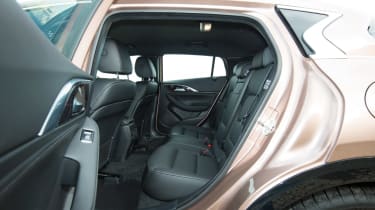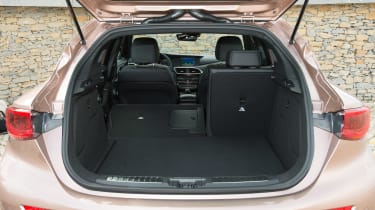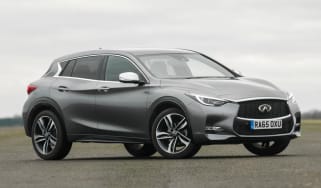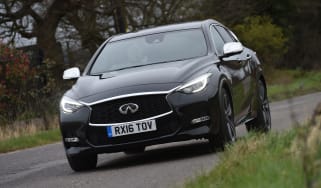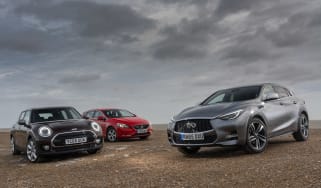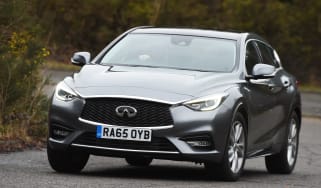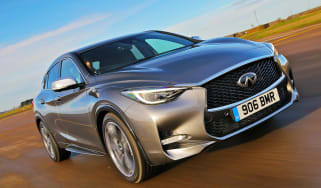Infiniti Q30 review
More than just a posh Nissan, the Infiniti Q30 is a Mercedes-based premium hatch built in Sunderland

The Infiniti Q30 is an intriguing alternative to the premium German hatchback norm. It won't be to all tastes, but the curvy exterior and plush cabin offer showroom appeal to rival some of the strongest cars in this class.
It's not a cheap, though. The lower-spec models look reasonable value, and are similar in price to the Audi A3 and BMW 1 Series. But flagship trims – particularly the Q30 2.0 Sport – are overpriced, and there are faster and more economical offerings on the market.
The Q30 is a good long-distance cruiser with soft suspension and a refined cabin. But show it a corner and things aren't as impressive. A slightly higher driving position than most hatchbacks will appeal to some, but practicality is hindered by an oddly-shaped boot and cramped rear seats.
Infiniti to Nissan what Lexus is to Toyota. As the Japanese maker's premium sub-brand, Infiniti hopes to capitalise on the market for high-spec, well-built alternatives to the German elite, with a range of new models specifically for Europe.
The Q30 is Infiniti's smallest model, and is based on the stong-selling Mercedes A-Class. It's built at Nissan's plant in Sunderland, UK, and should be just what the brand needs to properly kickstart it's ambitious European sales push.
Used - available now

2026 BMW
4 Series
26,030 milesAutomaticPetrol2.0L
Cash £25,997
2025 Audi
A5 Sportback
37,025 milesAutomaticDiesel2.0L
Cash £25,197
2026 BMW
i4
25,438 milesAutomaticElectric
Cash £29,197
2023 Land Rover
Range Rover Evoque
28,804 milesAutomaticPetrol1.5L
Cash £25,697Sharing its platform, basic bodyshell and a lot of its interior trim and electronics with the A-Class means it should be well built, while the large stylised grille and sweeping headlights give the Q30 its own distinctive look. The swooping curves and various angles are far more distinctive than the straight-laced Audi A3.
There are five trims on offer: SE, Premium, Premium Tech, Business Executive and Sport, while Infiniti offers an InTouch upgrade pack for Premium and Sport models to add more kit. As standard the Q30 looks sharp, but the Sport model gets a pumped-up look, with suspension lowered by 15mm lower, bigger wheels and bumpers, plus sports seats inside. Those who want a taller, SUV-inspired version can go for the QX30 crossover, which is essentially the Q30 with raised suspension.
There are four engine choices: a Renault-sourced 1.5 diesel and Mercedes' 2.1-litre diesel, plus 1.6 and 2.0-litre turbo petrol units, also from Mercedes. The 1.5 and 1.6-litre engines are both available with a six-speed manual or seven-speed auto, while the two larger engines are only available with the automatic gearbox.
The 2.1-litre diesel (badged 2.2) is available with both front-wheel drive or four-wheel drive, while the 208bhp 2.0-litre petrol is 4x4 only.
Rivals include Mercedes A-Class, Audi A3, Lexus CT 200h and BMW 1 Series. The (slightly) jacked-up QX30 offers a higher driving position and more crossover-like styling, rivalling cars like the Mercedes GLA.
Engines, performance and drive
The Infiniti Q30 isn’t particularly fun to drive, with a lacklustre engine range and uninspiring handling. The 1.5-litre turbodiesel is expected to be the most popular as it is the most efficient, but performance is adequate rather than sensational.
The Q30’s redeeming feature when it comes to the driving experience is its smooth ride. In fact, it's one of the most comfortable cars in its class, making effortless progress on longer motorway journeys. If you’re going to be doing a lot of miles, they’ll fly by in this car.
There's one proviso to this. The lower and stiffer suspension of Sport spec takes away some of this ride comfort, but doesn't offer much more in the way of agility or fun. The bigger brakes means it stops with confidence, but there's not much wrong with the standard set-up. Premium spec is a better choice.
City driving isn’t as easy as rivals thanks to less-than-perfect visibility, especially over the shoulder. It doesn’t make a meal of winding roads, but the class standards in driver enjoyment set by the Audi A3 and BMW 1 Series are a tough act to follow.
The manual gearbox is a little bit disappointing. The Q30 is claiming to be a premium car but its self-shifter doesn’t offer a sophisticated experience. The automatic DCT gearbox is smoother, but commands a hefty premium.
Engines
The most popular engine for the Q30 is the 1.5-litre turbodiesel. Although it might seem like a dull choice, for most buyers it will offer a decent blend of performance and running costs.
It has 108bhp, 260Nm of torque and will hit 0-62mph in 12 seconds, so you'll be revving it through the gears to make progress. It feels reasonably swift in the mid-range, however.
The 1.5 isn't the quietest unit, but more powerful engines (like the punchy 2.2-litre diesel) are available with noise cancelling technology in the speakers to cut out some of the clatter.
The 120bhp 1.6-litre turbo petrol is quiet at idle and on the move, but requires more revving than the diesel and efficiency takes a hit. The 154bhp DCT automatic model is worth avoiding on this engine, though, as it makes the hatchback feel decidedly lethargic despite being more powerful.
The one we'd avoid is the 2.0-litre petrol. It's not an unpleasant engine by any means (it's borrowed from the Mercedes GLA 250) with plenty of mid-range thrust and decent refinement. But it just isn't anywhere near as fast as hatchback rivals with a similar £32k price tag. 0-62mph takes 7.2 seconds - Vauxhall will sell you a 1.6-litre Astra that is faster than that.
MPG, CO2 and Running Costs
Compared to its rivals, the Infiniti Q30 won’t be the cheapest car to run. It won’t break the bank, but compared to the near-identical Mercedes A-Class (with which it shares most of it’s engines) the running costs are higher.
None of the engines drop below 100g/km, and the lowest emissions are 108g/km for the 1.5-litre diesel. This engine also achieves 68.9mpg on a combined cycle, which isn’t that impressive compared to the A-Class or BMW 1 Series, both producing over 80mpg from engines of similar performance.
Going up the range, the 120bhp 1.6-litre turbo petrol engine will achieve 47.1mpg on a combined cycle and emits 138g/km CO2. Go for the more powerful 154bhp DCT automatic model and things improve slightly, but 48.7mpg is hardly worth shouting about. Again, most rivals with similar performance claim greater efficiency.
The 2.0-litre Sport is, as you'd expect, the least efficient. Thanks to four-wheel-drive and an automatic gearbox it emits 156g/km of CO2 and has a combined economy figure of 42.2mpg. This is similar to a BMW 125i, which is notably quicker (and cheaper).
Sitting in the middle of all this is the 2.2-litre diesel, which offers a reasonable but not brilliant mix of efficiency and performance. Infiniti claims it will achieve 57.7mpg from its 166bhp engine and emits 134g/km of CO2.
Insurance groups
Insurance groups range from 13 on the low powered cars to 22 for the most powerful Sport model. In this respect the Q30 does fractionally better than its competition. The BMW 1 Series and Mercedes A-Class are only slightly higher, starting at group 15.
Interior, design and technology
The Q30 is clearly part of the Infiniti family and shares the curves of its relatives - but in a much more accentuated way. The curved grille and sweeping lights are also familiar. There are some questionable bits of trim around the boot opening but on the whole it appears to be very well built.
There is also the option of the Sport trim. This lowers the car by 15mm and the bulkier bumpers and black details add to the overall sportier look, even if it's subtle. The Sport model also sits on 19-inch wheels rather than the standard 18s, while Infiniti offers different wheel options, including rims with a purple pinstripe finish.
On the inside the Infiniti is well appointed and feels plush. Comfort is the key word here: You get the sense that Infiniti has built this car as a mile muncher, someone spending a lot of time in the driver’s seat would appreciate the pleasant materials and air of 'premium'. For example, the seats have been designed with the aim of supporting your upper and lower back to relieve pressure by not straining one particular part.
In terms of solidity and quality, however, it's a mixed bag. You'll find better fit-and-finish in German rivals, with certain areas feeling a bit flimsy and rattles on models we've tested.
On the technology front, the higher specification cars come with the option of sound cancelling speakers, to cut out some of the engine and road noise. When it comes to clever tech there isn’t anything particularly special on the Q30, however. The majority of electrical features you can see appear to be pinched from Mercedes, including the tablet-style infotainment screen and control wheel on the centre console. Automatic models show off their Mercedes roots further by having that firm's traditional column-mounted gear selector.
Sat-nav, stereo and infotainment
Infiniti's optional InTouch infotainment system is reasonably easy to use. The control interface is the same as the A-Class, and combines a touchscreen with a wheel and a selection of buttons on the centre console. This does make it easy to navigate using one or both ways of controlling the system, though there's no source or track skip buttons on the wheel. The mapping display looks very similar to the Mercedes COMAND system, too, but brighter colours do make it easier to read.
Practicality, comfort and boot space
The Q30 is only available as a five-door with five seats, but space isn't particularly generous. Taller drivers may find the Q30's footwell cramped, while those in the back aren't overly endowed with head or legroom. The car's roof line is rather low, too, so taller occupants may bang their heads getting in and out.
Passengers using the middle seat will be in for a squeeze, too, and there is the annoyance of the large transmission tunnel on the floor. In Sport models, the dark headlining combined with the large C-pillars mean it feels a bit claustrophobic.
Cabin storage isn’t brilliant. The glovebox is large enough for a 500ml water bottle, as are the door pockets but there’s not a lot more space other than that. There is the option of adding storage in the armrest to help ease the problem.
Boot space is 368 litres and whether you could actually use its full capacity is debatable. The shape of the boot is quite awkward because of the car's curvy design.
Visibility out of the front isn’t outstanding because of the chunky A-pillars, but it doesn’t cause any massive problems.
Dimensions and size
Overall the Q30 is almost 4.5m long (4,425mm) and 1.8m wide. This makes it longer that a Nissan Qashqai but not as tall and narrower. It’s also larger than a Mercedes A-Class, Volkswagen Golf or Audi A3, (although the A3 is wider) which makes the rear seat space all the more disappointing. It has 210mm ground clearance.
Leg room, head room & passenger space
Because the front seats in the Q30 are raised, you get enough extra room to tuck your feet under. However with the driver’s seat placed for someone six-foot tall, this would make legroom pretty tight for anyone sat behind.
The Q30 also gets electric adjustable seats with three memory settings and buttons mimicking the sections of the seat, although again, the door-mounted switches are exactly the same as the Mercedes A-Class'.
The rear doors open to almost 90-degress for access, but the roofline is a bit low and the narrowing at the bottom of the door does make stepping in awkward. Once you’re in, there are Isofix child seat brackets on the two outer seats.
Boot space
The boot is 368 litres with the rear seats in place. There are tie down points to secure your luggage and you should be able to fit a large suitcase, but the shape of the boot means you’ll struggle to fit more.
When we tested the car we managed to easily fit two medium-sized suitcases and some smaller bags without a problem. If you needed to carry more you can fold the rear seats with a 60:40 split, however they don’t go completely flat. The hatch opening is wide though, this means there’s no need to bend down to lift things out although there is a pronounced boot lip.
Reliability and Safety
The Q30 is available with Infiniti’s three-year or 60,000-mile warranty, which even covers any imperfections in the paint.
Safety features include Blind Spot Warning, that warns of other vehicles in neighbouring lanes hidden in the driver’s blind spots. Forward Collision Warning with Forward Emergency Braking, alerts the driver to hazards in the road ahead – and ultimately takes automatic action, applying the brakes to help avoid or mitigate the effects of a collision.
Auto High Beam Assist, a highly-intuitive technology improves safety during night-time driving by automatically dipping headlamps to avoid ‘blinding’ cars driving in the opposite direction. Meanwhile, intelligent Cruise Control can maintain a safe distance from the car in front for a safe and relaxing drive.
Euro NCAP gave the car a five-star crash test rating, thanks to this range of safety kit. Of special interest is the fact that the car has an excellent pedestrian score of 91 per cent

